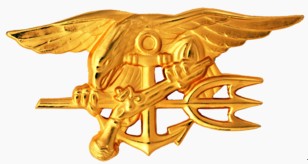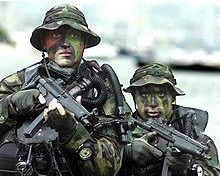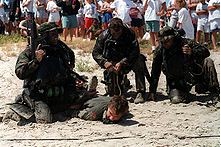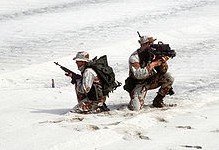
United States Navy SEALs
Us Info | 2013-11-29 15:33
| U.S. Navy SEALs | |
 The Special Warfare insignia, or "SEAL Trident." |
|
| Active | May 25, 1961–present |
| Country | United States of America |
| Branch | United States Navy |
| Type |
Special Operations Forces SEa, Air, Land |
| Role |
Primary tasks: Direct action Special reconnaissance Foreign internal defense Counter-terrorism Unconventional warfare Other roles: Counter-drug operations Personnel recovery Hydrographic reconnaissance |
| Part of |
United States Naval Special Warfare Command United States Special Operations Command |
| Garrison/HQ |
Coronado, California Little Creek, Virginia |
| Nickname | The Teams, Frogmen, The Green Faces |
| Motto |
"The Only Easy Day Was Yesterday" "It Pays to be a Winner" |
| Engagements |
Vietnam War Multinational Force in Lebanon Operation Urgent Fury Achille Lauro hijacking Operation Just Cause Operation Desert Storm Operation Restore Hope Battle of Mogadishu Operation United Shield Operation Enduring Freedom Operation Red Wings Operation Iraqi Freedom Maersk Alabama hijacking Death of Osama bin Laden |
The United States Navy's Sea, Air, and Land Teams, commonly known as the US Navy SEALs, are the U.S. Navy's principal special operations force and a part of the Naval Special Warfare Command (NSWC) and SOCOM.
"SEAL" is always capitalized in reference to members of the Naval Special Warfare community. The acronym is derived from their capacity to operate at sea, in the air, and on land. In the War on Terror, SEALs have been utilized almost exclusively for land-based operations, including Direct Action, Hostage Rescue, Counter Terrorism, Special Reconnaissance, unconventional warfare, manhunts and foreign internal defense operations. SEALs are male members of the United States Navy. An exchange program with the Coast Guard, which graduated three Coast Guardsmen as SEALs, was suspended in 2011.
The CIA's highly secretive Special Activities Division (SAD) and more specifically its elite Special Operations Group (SOG) recruits operators from the SEAL Teams.Joint Navy SEALs and CIA operations go back to the famed MACV-SOG during the Vietnam War.This cooperation still exists today and is seen in the wars in Iraq and Afghanistan, and in the finding and killing of Osama bin Laden in Pakistan.

History
Origins
Navy SEALs can trace their roots to the Second World War. The United States Navy recognized the need for the covertreconnaissance of landing beaches and coastal defenses. As a result, the Amphibious Scout and Raider School was established in 1942 at Fort Pierce, Florida. The Scouts and Raiders were formed in September of that year, just nine months after the attack on Pearl Harbor, from the Observer Group, a joint Army-USMC-Navy unit.
Scouts & Raiders
The first group included Phil H. Bucklew, the "Father of Naval Special Warfare," after whom the Naval Special Warfare Center building is named. Commissioned in October 1942, this group saw combat in November 1942 during Operation Torch on the North African coast. Scouts and Raiders also supported landings in Sicily, Salerno, Anzio, Normandy, and southern France.

A second group of Scouts and Raiders, code-named Special Service Unit No. 1, was established on 7 July 1943, as a joint and combined operations force. The first mission, in September 1943, was at Finschafen on New Guinea. Later operations were at Gasmata, Arawe, Cape Gloucester, and the East and South coast of New Britain, all without any loss of personnel. Conflicts arose over operational matters, and all non-Navy personnel were reassigned. The unit, renamed 7th Amphibious Scouts, received a new mission, to go ashore with the assault boats, buoy channels, erect markers for the incoming craft, handle casualties, take offshore soundings, blow up beach obstacles and maintain voice communications linking the troops ashore, incoming boats and nearby ships. The 7th Amphibious Scouts conducted operations in the Pacific for the duration of the conflict, participating in more than 40 landings.
The third Scout and Raiders organization operated in China. Scouts and Raiders were deployed to fight with the Sino-American Cooperative Organization, or SACO. To help bolster the work of SACO, Admiral Ernest J. King ordered that 120 officers and 900 men be trained for "Amphibious Raider" at the Scout and Raider school at Fort Pierce, Florida. They formed the core of what was envisioned as a "guerrilla amphibious organization of Americans and Chinese operating from coastal waters, lakes and rivers employing small steamboats and sampans." While most Amphibious Raider forces remained at Camp Knox in Calcutta, three of the groups saw active service. They conducted a survey of the upper Yangtze River in the spring of 1945 and, disguised as coolies, conducted a detailed three-month survey of the Chinese coast from Shanghai to Kitchioh Wan, near Hong Kong.

Naval Combat Demolition Units
Along with the Scouts and Raiders were the Naval Combat Demolition Units. They specialized in demolitions, explosive cable cutting, and commando raiding techniques. On 7 May 1943, Lieutenant Commander Draper L. Kauffman, "The Father of Naval Combat Demolition," was directed to set up a school and train people to eliminate obstacles on an enemy-held beach prior to an invasion. On 6 June 1943, LCDR Kaufmann established Naval Combat Demolition Unit training at Fort Pierce. By April 1944, a total of 34 NCDUs were deployed to England in preparation for Operation OVERLORD, the amphibious landing at Normandy. On 6 June 1944, in the face of great adversity, the NCDUs at Omaha Beach managed to blow eight complete gaps and two partial gaps in the German defenses. The NCDUs suffered 31 killed and 60 wounded, a casualty rate of 52%. Meanwhile, the NCDUs at Utah Beach met less intense enemy fire. They cleared 700 yards (640 metres) of beach in two hours, another 900 yards (820 metres) by the afternoon.
Casualties at Utah Beach were significantly lighter with six killed and eleven wounded. During Operation OVERLORD, not a single demolitioneer was lost to improper handling of explosives. In August 1944, NCDUs from Utah Beach participated in the landings in southern France, the last amphibious operation in the European Theater of Operations. NCDUs also operated in the Pacific theater. NCDU 2, under LTjg Frank Kaine, after whom the Naval Special Warfare Command building is named, and NCDU 3 under LTjg Lloyd Anderson, formed the nucleus of six NCDUs that served with the Seventh Amphibious Force tasked with clearing boat channels after the landings from Biak to Borneo.

OSS Operational Swimmers
Some of the earliest World War II predecessors of the SEALs were the Operational Swimmers of the Office of Strategic Services, or OSS. Many current SEAL missions were first assigned to them. OSS specialized in special operations, dropping operatives behind enemy lines to engage in organized guerrilla warfare as well as to gather information on such things as enemy resources and troop movements. British Combined Operations veteran LCDR Wooley, of the Royal Navy, was placed in charge of the OSS Maritime Unit in June 1943. Their training started in November 1943 at Camp Pendleton, California, moved to Santa Catalina Island, California in January 1944, and finally moved to the warmer waters of The Bahamas in March 1944. Within the U.S. military, they pioneered flexible swimfins and diving masks, closed-circuit diving equipment (under the direction of Dr. Christian J. Lambertsen), the use of Swimmer Delivery Vehicles (a type of submersible), and combat swimming and limpet mine attacks.In May 1944, General Donovan, the head of the OSS, divided the unit into groups. He loaned Group 1, under Lieutenant Choate, to Admiral Nimitz, as a way to introduce the OSS into the Pacific theater. They became part of UDT-10 in July 1944. Five OSS men participated in the very first UDT submarine operation with the USS Burrfish in the Caroline Islands in August 1944.
Underwater Demolition Teams
On 23 November 1943, the U.S. Marinelanding on Tarawa Atoll emphasized the need for hydrographic reconnaissance and underwater demolition of obstacles prior to any amphibious landing. Offshore coral reefs and other obstacles in the surf had resulted in many of the Marines drowning or being hit by enemy fire because their landing craft could not reach the beach. After the Tarawa, Rear Admiral Richmond K. Turner directed the formation of nine Underwater Demolition Teams. 30 officers and 150 enlisted men were moved to the Waimānalo Amphibious Training Base to form the nucleus of a demolition training program. This group became Underwater Demolition Teams (UDT) ONE and TWO.
The UDTs saw their first combat on 31 January 1944, during Operation Flintlock in the Marshall Islands. FLINTLOCK became the real catalyst for the UDT training program in the Pacific Theater. In February 1944, the Naval Combat Demolition Training and Experimental Base was established at Kīhei, Maui, next to the Amphibious Base at Kamaole. Eventually, 34 UDT teams were established. Wearing swim suits, fins, and dive masks on combat operations, these "Naked Warriors" saw action across the Pacific in every major amphibious landing including: Eniwetok, Saipan, Guam, Tinian, Angaur, Ulithi, Peleliu, Leyte, Lingayen Gulf, Zambales, Iwo Jima, Okinawa, Labuan, Brunei Bay, and on 4 July 1945 at Balikpapan on Borneo, which was the last UDT demolition operation of the war. The rapid demobilization at the conclusion of the war reduced the number of active duty UDTs to two on each coast with a complement of seven officers and 45 enlisted men each.
Korean War
The Korean War began on 25 June 1950, when the North Korean army invaded South Korea. Beginning with a detachment of 11 personnel from UDT 3, UDT participation expanded to three teams with a combined strength of 300 men. As part of the Special Operations Group, or SOG, UDTs successfully conducted demolition raids on railroad tunnels and bridges along the Korean coast. On 15 September 1950, UDTs supported Operation Chromite, the amphibious landing at Incheon. UDT 1 and 3 provided personnel who went in ahead of the landing craft, scouting mud flats, marking low points in the channel, clearing fouled propellers, and searching for mines. Four UDT personnel acted as wave-guides for the Marine landing. In October 1950, UDTs supported mine-clearing operations in Wonsan Harbor where frogmen would locate and mark mines for minesweepers. On 12 October 1950, two U.S. minesweepers hit mines and sank. UDTs rescued 25 sailors. The next day, William Giannotti conducted the first U.S. combat operation using an "aqualung" when he dove on the USS Pledge (AM-277). For the remainder of the war, UDTs conducted beach and river reconnaissance, infiltrated guerrillas behind the lines from sea, continued mine sweeping operations, and participated in Operation Fishnet, which devastated the North Korean's fishing capability.

Birth of Navy SEALs & Vietnam
President John F. Kennedy, aware of the situations in Southeast Asia, recognized the need for unconventional warfare and special operations as a measure against guerrilla warfare. In a speech to Congress on 25 May 1961, Kennedy spoke of his deep respect for the United States Army Special Forces. While his announcement of the government's plan to put a man on the moon drew all of the attention, in the same speech he announced his intention to spend over $100 million to strengthen U.S. special operations forces and expand American capabilities in unconventional warfare.
The Navy needed to determine its role within the special operations arena. In March 1961, Arleigh Burke, Chief of Naval Operations, recommended the establishment of guerrilla and counter-guerrilla units. These units would be able to operate from sea, air or land. This was the beginning of the Navy SEALs. Most SEALs came from the Navy's Underwater Demolition Teams, who had already gained extensive experience in commando warfare in Korea; however, the Underwater Demolition Teams were still necessary to the Navy's amphibious force.
Members of SEAL Delivery Vehicle Team Two in a Dry Deck Shelter of the submerged USS Philadelphia
The first two teams were on both US coasts: Team One at Naval Amphibious Base Coronado, in San Diego, California and Team Two at Naval Amphibious Base Little Creek, in Virginia Beach, Virginia. Men of the newly formed SEAL Teams were trained in such unconventional areas as hand-to-hand combat, high-altitude parachuting, demolitions, and foreign languages. The SEALs attended Underwater Demolition Team replacement training and they spent some time training in UDTs. Upon making it to a SEAL team, they would undergo a SEAL Basic Indoctrination (SBI) training class at Camp Kerry in the Cuyamaca Mountains. After SBI training class, they would enter a platoon and conduct platoon training.
According to founding SEAL team member Roy Boehm the SEAL's first missions were directed against communist Cuba. These consisted of deploying from submarines and carrying out beach reconnaissance in prelude to a proposed US amphibious invasion of the island. On at least one occasion Boehm and another SEAL smuggled a CIA agent ashore to take pictures of Soviet nuclear missiles being unloaded on the dockside.
The Pacific Command recognized Vietnam as a potential hot spot for unconventional forces. At the beginning of 1962, the UDTs started hydrographic surveys and along with other branches of the US Military, the Military Assistance Command Vietnam (MACV) was formed. In March 1962, SEALs were deployed to South Vietnam as advisors for the purpose of training Army of the Republic of Vietnamcommandos in the same methods they were trained themselves.
The Central Intelligence Agency began using SEALs in covert operations in early 1963. The SEALs were involved in the CIA sponsored Phoenix Program where it targeted key North Vietnamese Army personnel and Vietcong sympathizers for capture and assassination.
The SEALs were initially deployed in and around Da Nang, training the South Vietnamese in combat diving, demolitions, and guerrilla/anti-guerrilla tactics. As the war continued, the SEALs found themselves positioned in the Rung Sat Special Zone where they were to disrupt the enemy supply and troop movements and in the Mekong Delta to fulfill riverine operations, fighting on the inland waterways.
Combat with the Viet Cong was direct. Unlike the conventional warfare methods of firing artillery into a coordinate location, the SEALs operated within inches of their targets. Into the late 1960s, the SEALs were successful in a new style of warfare, effective in anti-guerrilla and guerrilla actions. SEALs brought a personal war to the enemy in a previously safe area. The Viet Cong referred to them as "the men with green faces," due to the camouflageface paint the SEALs wore during combat missions.
SEALs continued to make forays into North Vietnam and Laos, and covertly into Cambodia, controlled by the Studies and Observations Group. The SEALs from Team Two started a unique deployment of SEAL team members working alone with South Vietnamese Commandos (ARVN). In 1967, a SEAL unit named Detachment Bravo (Det Bravo) was formed to operate these mixed US and ARVN units, which were called South Vietnamese Provincial Reconnaissance Units (PRUs).
At the beginning of 1968, the North Vietnamese and the Viet Cong orchestrated a major offensive against South Vietnam: the "Tet Offensive". The North hoped it would prove to be America's Dien Bien Phu, attempting to break the American public's desire to continue the war. As propaganda, the Tet Offensive was successful in adding to the American protest of the Vietnam war. However, North Vietnam suffered tremendous casualties, and from a purely military standpoint, the Tet Offensive was a major disaster for the Communists.
By 1970, President Richard Nixon initiated a Plan of Vietnamization, which would remove the US from the Vietnam War and return the responsibility of defense back to the South Vietnamese. Conventional forces were being withdrawn; the last SEAL advisor left Vietnam in March 1973 and Vietnam fell to the communists in 1975. The SEALs were among the highest decorated units for their size in the war. SEALs were awarded 2 Navy Crosses, 42 Silver stars, 402 Bronze Stars, 2 Legions of Merit, 352 Commendation Medals, 3 Presidential Unit Citations and 3 Medals of Honor.
Share this page



















